When you smell a roasted turkey or a juicy steak, you know something special is coming. But what really makes the meal is a rich, velvety gravy. Making homemade gravy might seem hard, but this easy recipe makes it simple and quick, ready in just 15 minutes.
Imagine you’ve just taken a golden-brown turkey out of the oven. Your guests are waiting to taste it. But then, you remember the gravy. Don’t worry, this simple recipe will have you with a delicious gravy in no time. You can use homemade broth, store-bought stock, or even the pan drippings.
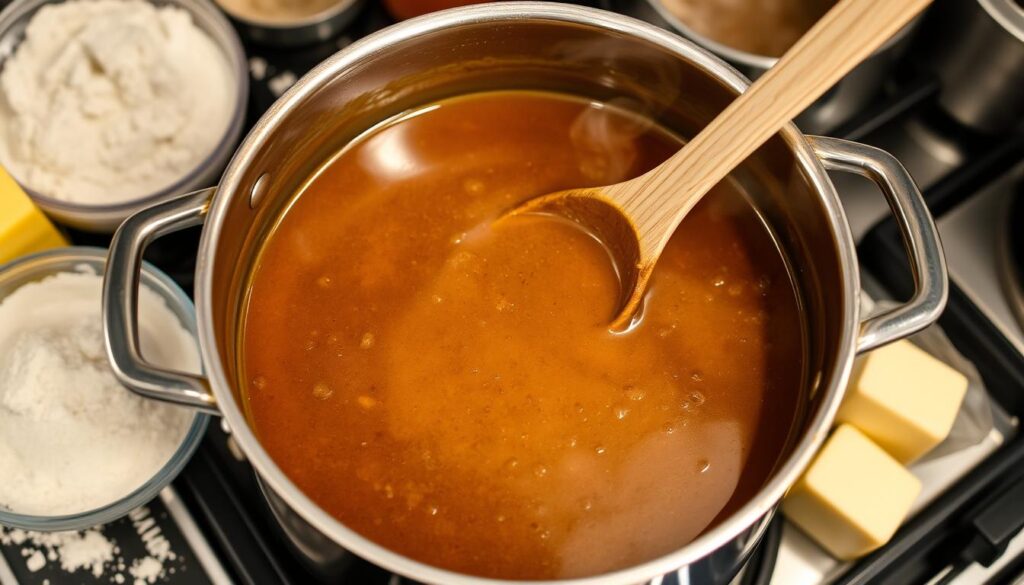
Table of Contents
Key Takeaways
- Homemade gravy can be made in just 15 minutes
- This recipe works for chicken, turkey, beef, or vegetable-based gravies
- You can use homemade broth, store-bought stock, or pan drippings
- The recipe yields approximately 3 cups of gravy
- It’s perfect for both weeknight dinners and holiday meals
Why This Classic Gravy Recipe Works
This gravy recipe is a favorite in many homes. It makes any meal better, from weeknight dinners to big holiday feasts. You can make turkey gravy, beef gravy, or even a vegetarian gravy with it. Every time, it tastes great.
Perfect for Every Occasion
This gravy is great for any meal. You can use it with or without pan drippings. It’s perfect with turkey, mashed potatoes, steaks, or roasted veggies.
Quick and Simple Method
Making homemade gravy is easy and fast. It only takes about 15 minutes. This makes it perfect for busy days or sudden holiday meals. You’ll have delicious gravy ready in no time.
Versatile Applications
This gravy is more than just a side dish. It’s a base for sauces and dishes. Use it in pot pies or to enhance meatloaf. It adds a rich, savory flavor to many dishes.
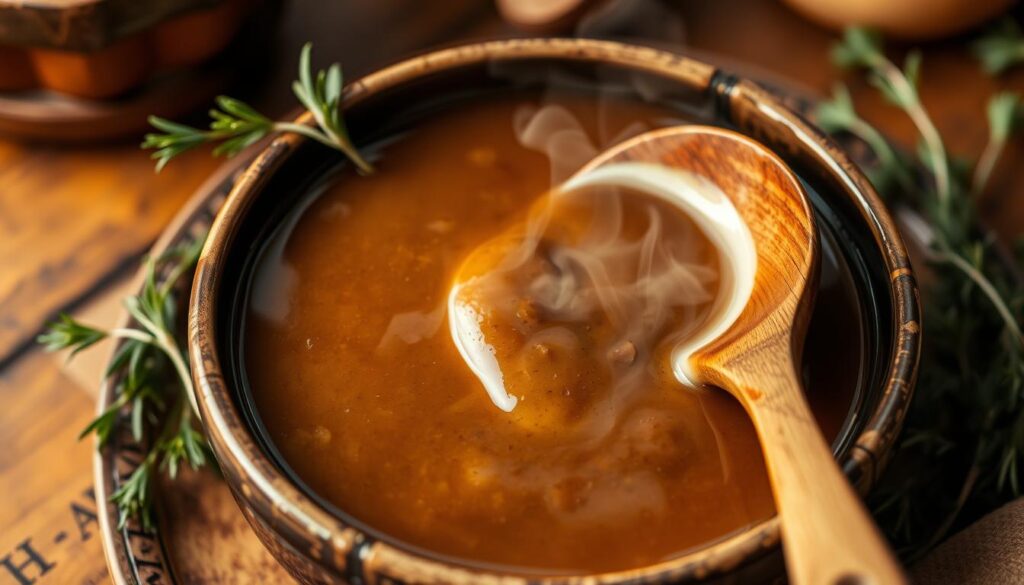
“This gravy is a game-changer. It’s so easy to make, but the flavor is out of this world. I use it for everything from Thanksgiving dinner to weeknight meatloaf.”
Essential Ingredients for Perfect Gravy
Making homemade gravy is all about rich texture and flavor. You need a few key ingredients. First, a roux made from butter and flour is crucial. It thickens your gravy. Then, a good stock or homemade broth adds the savory taste.
To make the roux, mix equal parts unsalted butter and flour. Cook it over medium heat, stirring constantly. It should turn light golden-brown and smell nutty in 4 to 5 minutes. This step makes your gravy smooth and lump-free.
| Ingredient | Percentage |
|---|---|
| Broth or stock | 4 cups (80%) |
| Unsalted butter | 10 tablespoons (10%) |
| All-purpose flour | 2/3 cup (10%) |
For extra flavor, add a tablespoon of bouillon paste or concentrated stock. Herbs like sage, thyme, and rosemary also enhance the taste. A bit of heavy cream can make your gravy even richer.
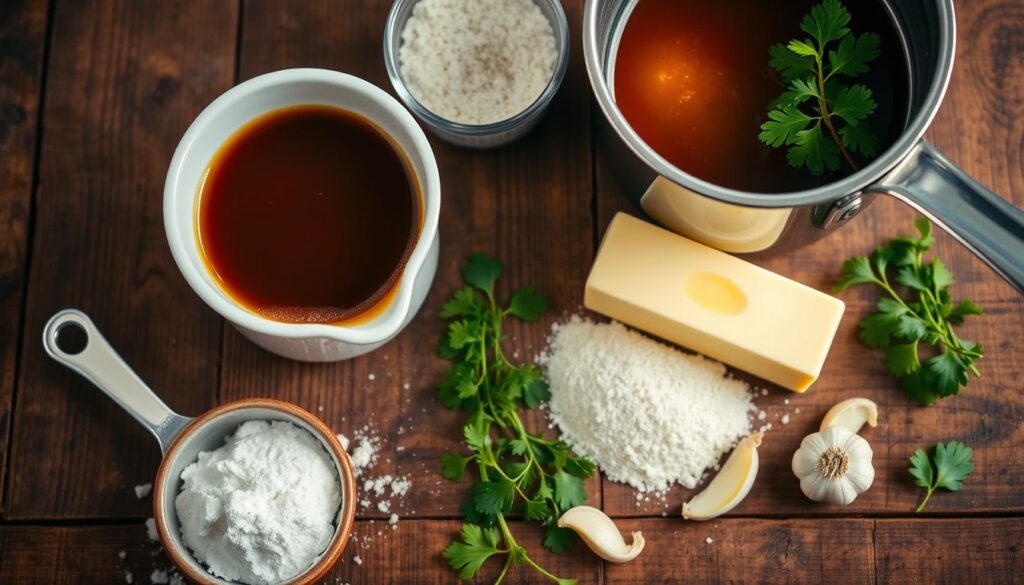
Whether you use pan drippings or start with homemade stock, these ingredients will make your gravy stand out.
The Basic Gravy Recipe
Making a smooth, tasty gravy at home is simple. The key is the 2:2:1 ratio – 2 tablespoons of fat, 2 tablespoons of flour, and 1 cup of stock. This classic recipe can make any meal better, from Thanksgiving turkey to a simple dinner.
Understanding the 2:2:1 Ratio
The 2:2:1 ratio is the base for a great gravy. Begin by melting 2 tablespoons of butter or fat in a pan. Then, mix in 2 tablespoons of flour. This roux thickens your stock or drippings into a smooth gravy.
Step-by-Step Instructions
- In a saucepan, melt 2 tablespoons of butter or fat over medium heat.
- Whisk in 2 tablespoons of flour and cook for 1-2 minutes, stirring constantly, until the roux is lightly golden.
- Slowly whisk in 1 cup of warm stock or broth, making sure there are no lumps.
- Simmer the mix, stirring now and then, until it thickens, about 1-2 minutes.
- Season with salt and pepper to taste.
Tips for Smooth Results
- Use a whisk to mix the flour into the fat, avoiding lumps.
- Slowly add the warm stock or broth to the roux, whisking constantly to avoid lumps.
- Simmer the gravy, stirring often, until it’s the right thickness.
- For a smoother gravy, strain it through a fine-mesh sieve before serving.
With this basic gravy recipe, you can make a delicious homemade gravy. Try adding different herbs, seasonings, or a bit of wine to make it your own.
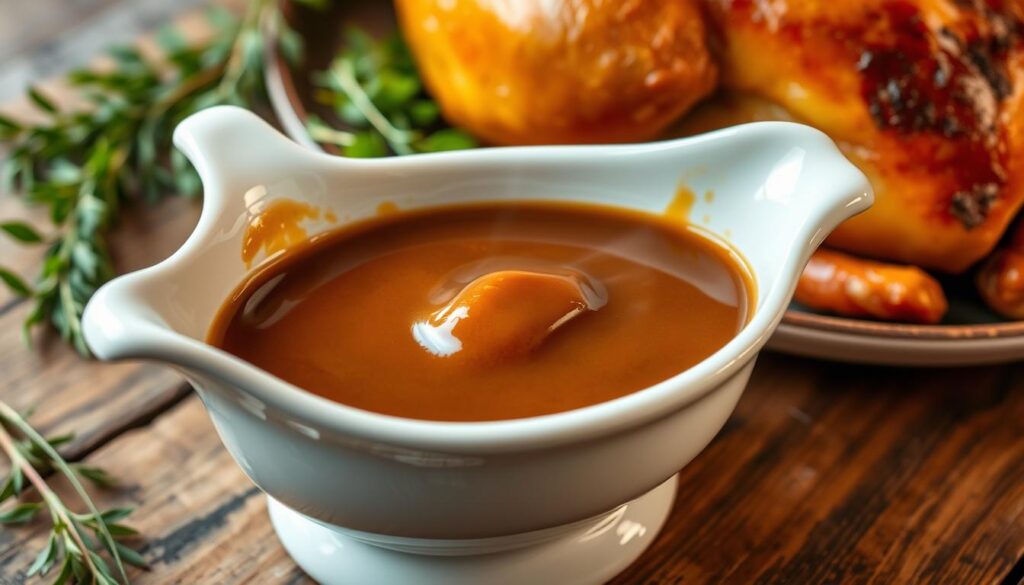
How to Make Gravy Without Pan Drippings
Preparing a holiday feast without pan drippings? No worries! You can make a tasty, butter-based gravy in 15 minutes. This method makes about 2 cups of gravy, perfect for 4 to 6 people. Each person should get ⅓ to ½ cup, so it’s plenty for your meal.
Start by melting butter in a saucepan over medium heat. Once melted, mix in all-purpose flour to make a roux. Slowly add warm broth or stock, whisking all the time to avoid lumps. Add salt and pepper to taste, and think about adding fresh herbs, mushroom powder, or a bit of Worcestershire sauce for more flavor.
Keep cooking the gravy without drippings until it’s the right thickness, about 5 to 10 minutes. If it’s too thin, add a little flour mixed with water or milk. If it’s too thick, just add more broth or stock.
This butter-based gravy can be made up to 3 days ahead and kept in the fridge. Or, freeze it for up to 3 months in a sealed container. To serve, just reheat it on the stovetop or in the microwave until it’s warm.
For a gluten-free gravy, use cornstarch instead of flour. This gravy without drippings goes great with mashed potatoes, roasted meats, or your favorite holiday sides. It’s easy to make and delicious.
Working with Pan Drippings for Enhanced Flavor
Homemade gravy gets its best flavor from pan drippings. These drippings, full of umami, make your gravy rich and velvety. Let’s learn how to collect and separate the turkey drippings for a delicious gravy.
Collecting and Separating Drippings
First, let the turkey drippings cool a bit after removing the roasted item. This makes straining easier. Use a fine-mesh sieve to strain the drippings into a clean container.
Then, put the strained drippings in a fat separator or chill them in the fridge. This way, you can easily skim off the solidified fat. The liquid gold stays below, ready for your gravy.
Using a Fat Separator
A fat separator makes separating fat from drippings easy. Just pour the warm drippings in and let the fat rise. The spout lets you drain the flavorful liquid, leaving the fat behind.
This method ensures you get every bit of flavor for your gravy.
| Ingredient | Amount |
|---|---|
| Turkey Drippings | 1/2 cup |
| Unsalted Butter | 2 tablespoons |
| All-Purpose Flour | 2 tablespoons |
| Chicken or Turkey Stock | 2 cups |
| Salt and Pepper | To Taste |
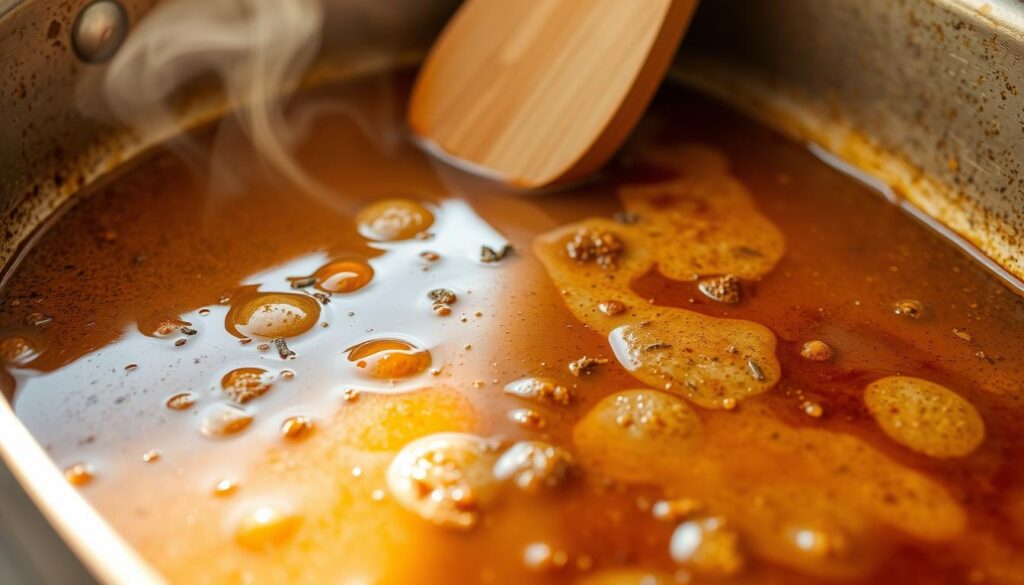
“The secret to truly exceptional gravy lies in the perfect balance of rich pan drippings and a silky smooth texture.”
Common Gravy Thickening Methods
Getting your gravy just right is essential for a great meal. Whether it’s a big Thanksgiving dinner or a cozy weeknight dinner, knowing how to thicken gravy is important. Let’s look at the top ways to get your gravy to the perfect thickness.
The Roux Technique
Using a roux is a classic and reliable way to thicken gravy. A roux is made from equal parts flour and fat, cooked until it’s nutty and fragrant. This method thickens the gravy and adds flavor. Just whisk the roux into the hot gravy and stir until it’s the right consistency.
Cornstarch Slurry
For those who need a gluten-free option, cornstarch works great. Mix 1 tablespoon of cornstarch with 2 tablespoons of cold water to make a slurry. Whisk this into the hot gravy and it will start to thicken right away. Add the slurry slowly to get the perfect thickness.
You can also try other thickening agents like arrowroot powder, potato starch, or pureed cooked veggies. Try different methods to find what works best for you.
Choosing the right thickening method is key. Add the agent slowly and let the gravy simmer until it’s just right. Remember, patience and attention are important when thickening gravy. With a bit of practice, you’ll make gravies that everyone will love.
Flavor Variations and Add-ins
Make your homemade gravy even better with different flavors. Try adding fresh herbs like sage, thyme, or rosemary. These herbs give your herb gravy a unique and earthy taste.
For a deeper flavor, add mushroom powder, Worcestershire sauce, or soy sauce to your umami gravy. These ingredients add a savory depth that enhances your gravy.
Want a gravy with a strong onion flavor? Sauté chopped onions in butter before making the roux. This step adds sweet, caramelized notes that go well with roasted meats or mashed potatoes.
Try using different stocks like beef, chicken, or vegetable to change the flavor. This way, you can find the perfect match for your main dish.
| Flavor Add-in | Description |
|---|---|
| Fresh Herbs | Sage, thyme, rosemary, parsley |
| Umami Boosters | Mushroom powder, Worcestershire sauce, soy sauce |
| Caramelized Onions | Sauté onions in butter before making the roux |
| Variety of Stocks | Beef, chicken, vegetable |
By trying out these flavor variations and add-ins, you can make a gravy that’s truly your own. It will make any meal even better.
Troubleshooting Common Gravy Issues
Homemade gravy can sometimes face unexpected problems. But, with a few simple tips, you can fix these issues easily. Whether it’s lumpy gravy, thin gravy, or thick gravy, we’ve got solutions to make it perfect.
To avoid lumps, whisk constantly when adding liquid to the roux. If lumps still form, strain the gravy through a fine-mesh sieve or blend it. A trick is to mix 2 cups of room-temperature stock with 1 tablespoon of instant flour. Then, whisk this slurry into the gravy to dissolve lumps.
If your gravy is too thin, simmer it longer to reduce the liquid and thicken. Or, make a beurre manié by mixing flour and butter, then whisk it into the gravy to thicken it.
For too thick gravy, whisk in more stock or water slowly. Be careful not to over-thicken, as it can taste starchy.
Got an oversalted gravy? No worries. Make an unseasoned roux and stock, then mix them into the salty gravy. Or, add a splash of soy sauce to balance the flavors and enhance umami.
Remember, fixing gravy issues quickly and calmly is key. With these tips, you can turn any gravy into a smooth, tasty side dish.
Storage and Reheating Tips
Storing and reheating your homemade gravy right is key. It keeps the flavor and makes sure it’s safe to eat. These tips will help you enjoy your gravy more, whether it’s leftover gravy or a big batch.
To store leftover gravy, put it in an airtight container and chill it for up to 4 days. Warm it up gently over low heat, stirring often. If it’s too thick, add a bit of broth or water.
For freezing, your gravy can last up to 6 months. Cool it down first, then put it in a freezer-safe container. Thaw it in the fridge overnight and reheat it on the stovetop.
When reheating leftover gravy, don’t boil it. Boiling can ruin the texture and make it separate. Heat it over low heat, stirring constantly, until it’s smooth and warm.
“Proper storage and reheating techniques are the keys to enjoying your homemade gravy long after it’s been prepared.”
Follow these easy tips to enjoy your homemade gravy for days or weeks. Visit our website for more tips on making and keeping your gravy perfect.
What to Serve with Your Homemade Gravy
Homemade gravy is the ultimate comfort food topping. It makes any dish better with its rich, savory flavor. You can pair it with classic favorites or try something new.
Classic Pairings
Classic gravy companions include mashed potatoes, roasted turkey, chicken, or beef. Mashed potatoes are perfect for gravy because of their creamy texture. Roasted meats like turkey, chicken, or beef also pair well.
Gravy is great over stuffing or fluffy biscuits too. It’s also tasty with roasted vegetables like mashed potatoes or roasted vegetables. This adds a nice contrast of textures and flavors.
Modern Serving Suggestions
For a twist, try gravy over cauliflower mash or zucchini noodles. This makes for a lighter, yet satisfying, meal. The gravy’s richness complements the subtle flavors of these veggie dishes.
Gravy is also great as a dipping sauce. It’s perfect for crispy fries, roasted potatoes, or steamed or roasted vegetables. The savory flavors of the gravy make these simple sides irresistible.
“Homemade gravy is the ultimate comfort food topping, elevating a variety of dishes with its rich, savory flavor.”
How you serve your homemade gravy doesn’t matter. The key is to let its comforting flavors shine. Whether you stick to classics or try new things, it’s sure to add flavor to your meal.
Make-Ahead and Freezing Instructions
Preparing your homemade gravy in advance can be a game-changer. This classic gravy recipe can be made up to 5 days ahead. Store it in the refrigerator for a delicious topping whenever you need it. For longer-term storage, freeze it for up to 6 months, perfect for busy cooks.
To freeze the gravy, pour it into airtight containers or freezer-safe bags. Leave a bit of headspace for expansion. When thawing, let it sit overnight in the fridge. Then, reheat it gently on the stovetop, adding stock or broth if it’s too thick.
Having a stash of this make-ahead gravy is great for any meal. It’s perfect for holiday feasts or weeknight meals. With these tips, enjoy homemade gravy whenever you want, saving you time and effort.
F.A.Q
What makes this gravy recipe versatile?
This gravy recipe is great for any time. It’s perfect for everyday meals or special holiday feasts. You can make it with or without pan drippings. It also works well with different meats or as a vegetarian option using vegetable broth.
How long does it take to make this gravy?
Making this gravy is quick. It only takes 10 minutes. This makes it perfect for weeknight dinners or holiday meals.
What are the key ingredients in this gravy recipe?
The main ingredients are butter and flour for the roux. You also need stock or pan drippings. Herbs like sage, thyme, and rosemary add flavor. You can also add mushroom powder for umami and cream for extra richness.
What is the 2:2:1 ratio for this gravy recipe?
The basic recipe uses a 2:2:1 ratio. This means 2 tablespoons of fat, 2 tablespoons of flour, and 1 cup of stock. This ratio helps create a roux that thickens the gravy when whisked into warm stock.
How can I make gravy without pan drippings?
To make gravy without pan drippings, start with butter. Melt it in a pan, then add flour to make a roux. Slowly whisk in warm stock. Season with salt, pepper, and herbs or flavor enhancers like mushroom powder or Worcestershire sauce.
How do I use pan drippings to make gravy?
First, let the pan drippings cool a bit after removing the meat. Then, strain them and separate the fat from the liquid. Use the fat instead of butter and the liquid as part of your stock for extra flavor.
What are the common thickening methods for gravy?
The most common way is using a roux (flour and fat mixture). For gluten-free options, mix cornstarch with cold water before adding to simmering liquid. Adjust the liquid amount to get the right thickness, adding more stock if it’s too thick or simmering longer if it’s too thin.
How can I enhance the flavor of my gravy?
Boost the flavor with fresh herbs like sage, thyme, or rosemary. Add umami with mushroom powder, Worcestershire sauce, or soy sauce. For onion gravy, sauté chopped onions in butter before making the roux. Try different stocks (beef, chicken, vegetable) for unique flavors.
How do I prevent and fix lumps in my gravy?
To avoid lumps, whisk constantly when adding liquid to the roux. If lumps form, strain the gravy or blend it smooth. For thin gravy, simmer longer or add a cornstarch slurry. If it’s too thick, whisk in more stock or water until it’s right.
How can I store and reheat leftover gravy?
Cool the gravy and store it in an airtight container in the fridge for up to 5 days. Reheat it gently over low heat, stirring often. If it’s too thick, thin it with a little stock or water. For longer storage, freeze it for up to 3 months.
What are some classic and modern ways to serve homemade gravy?
Serve it with mashed potatoes, roasted turkey, chicken, or beef for a classic touch. It’s also great with roasted vegetables, stuffing, or biscuits. For something new, try it over cauliflower mash, zucchini noodles, or as a dipping sauce for fries or vegetables.



